Are you thinking of starting an online business or side hustle? Does the creator economy excite you and inspire you to get paid for your expertise and creativity?
An Exact Roadmap To Attracting Your First Or Next 1,000 Email Subscribers - Post Outline
An email list may be the perfect growth strategy for you. That being said, there are strategies you may want to keep in mind so you don’t get discouraged along the way.
In this post, we’ll talk through everything you need to go from zero to your first 1,000 subscribers and beyond.
Why It’s Not Too Late to Start Growing an Email List
I know it’s not too late to start growing an email list because I’m doing it now, despite starting very late, and you can do the same.
Here’s how it all played out: I originally was turned on to online business by Ramit Sethi, a personal finance and entrepreneurship author. Ramit came out with a course in 2013 called Zero To Launch, which taught you how to build a business powered by online courses or other forms of intellectual property. Zero To Launch has four modules:
- Validate your idea,
- Grow an audience of email subscribers through content,
- Produce a small information product, and
- Launch your product within a specific time window.
One would think the “launch” part is the hardest part of this framework, but it isn't. The toughest part of starting an online business is growing a quality, engaged audience. In Ramit’s course, each module has recommended benchmarks to hit before moving on. The benchmark for module 2 was to have 1,000 email subscribers. For many people, that’s a lot.
I just could not hit that number. While I knew how to run email marketing for businesses that already had well-established lists, such as gyms, I was failing miserably on the audience validation side for myself, so I gave up and never finished the course.
I took a different online business route and focused my skill set into more niche, 1-to-1 consulting offerings instead. I built up my side hustle, and eventually made it my full-time gig. I abandoned the idea of having a creator-style personal brand for the time being.
After finishing up a 2.5-year stint with a client last year, however, I needed to try something new. I had gotten sharper, wanted to give creator life another swing, and felt ready to grow an audience as a way to spread the word and help rebuild my client book.
Then COVID-19 rolled in.
And it sucked. Companies were holding their dollars tight in those first few months, and no one wanted my $5,000 deep-dive consulting packages.
I needed to pivot my business into smaller, bite-size offerings. And to make it all work, I needed way more volume — that meant building an audience. (I discussed this pivot in a recent interview with SamCart.) When you have an audience — and can reach this audience easily — everything is easier in this online game.
An audience takes time to grow. And that’s probably what makes list growth a touchy subject.
Everyone wants to know how you grew your audience of customers and potential customers, and if you talk about how an audience helps you get business results you’re met with disbelief.
Here are a few reader remarks I ladled out of the comments section from one of my past posts:
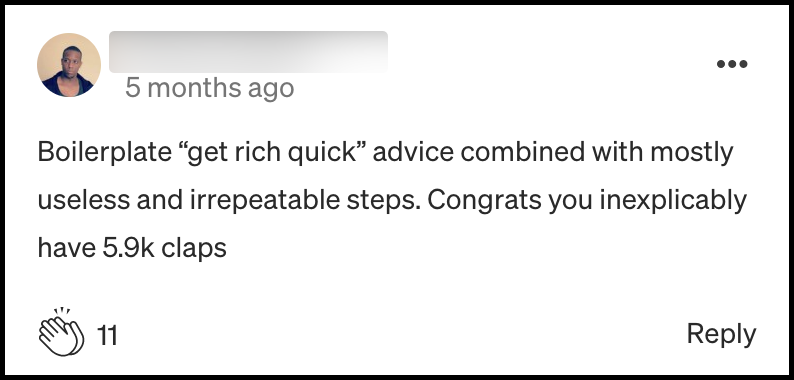
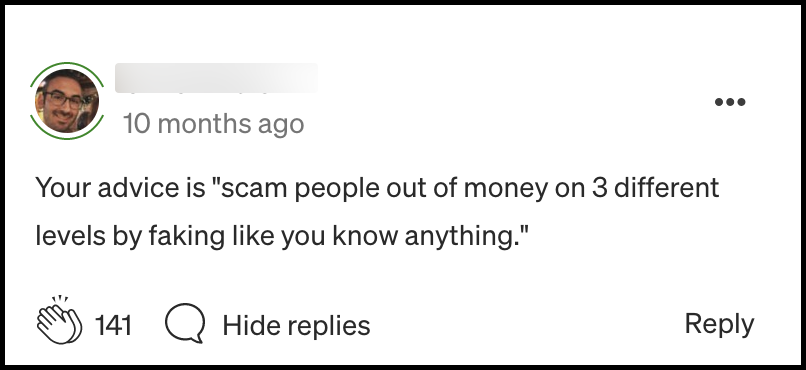

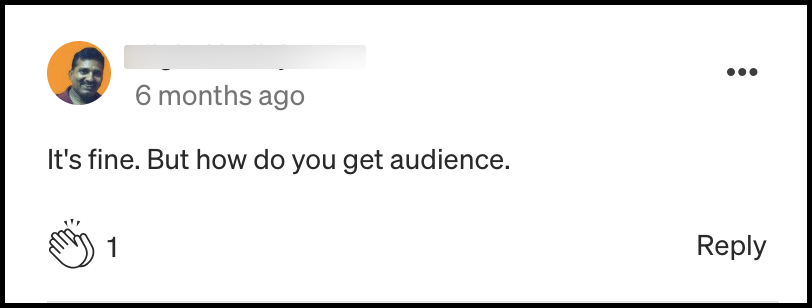
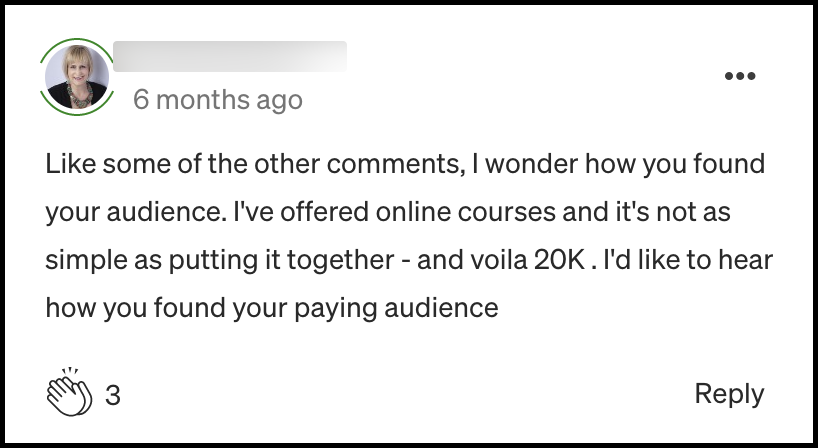
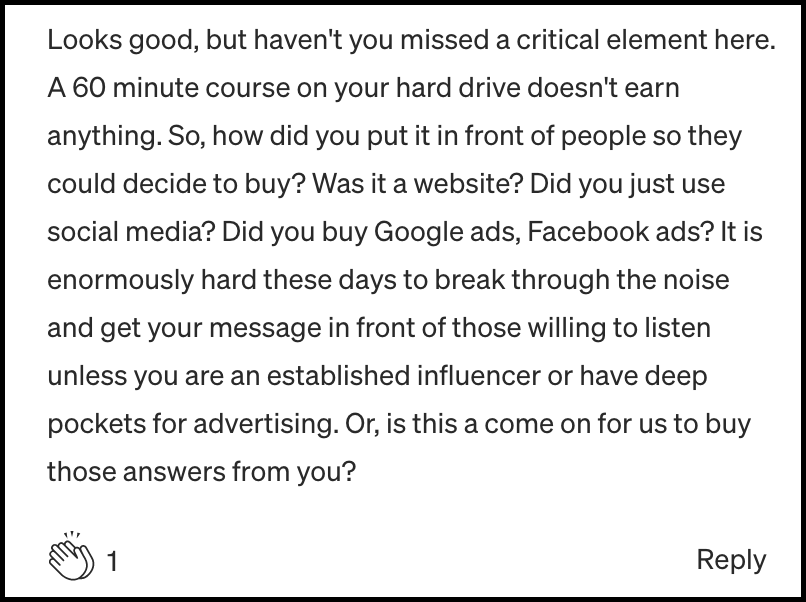
It’s triggering for people. And it’s understandable: Marketers on every platform say it’s the best platform and their approach is the greatest thing since sliced bread.
If your goal is to start or grow an audience that will potentially purchase your online products, programs, or services, an email list is best. People write off email as a viable approach – so let’s take a look at the some of the most popular dismissals.
The Most Common Objections To Building An Email List
“No one reads email”
Actually, they do. And there’s more: Boring, text-only emails that invite small action often do very well.
Michael Stelzner, the founder of Social Media Examiner, notes that when his publication tested different formatting options for their email newsletter, which goes out to over 500,000 people each week, the most stripped-down version performed the best.
Their newsletters now look like this: Simple and clear with links to articles that may be of interest.
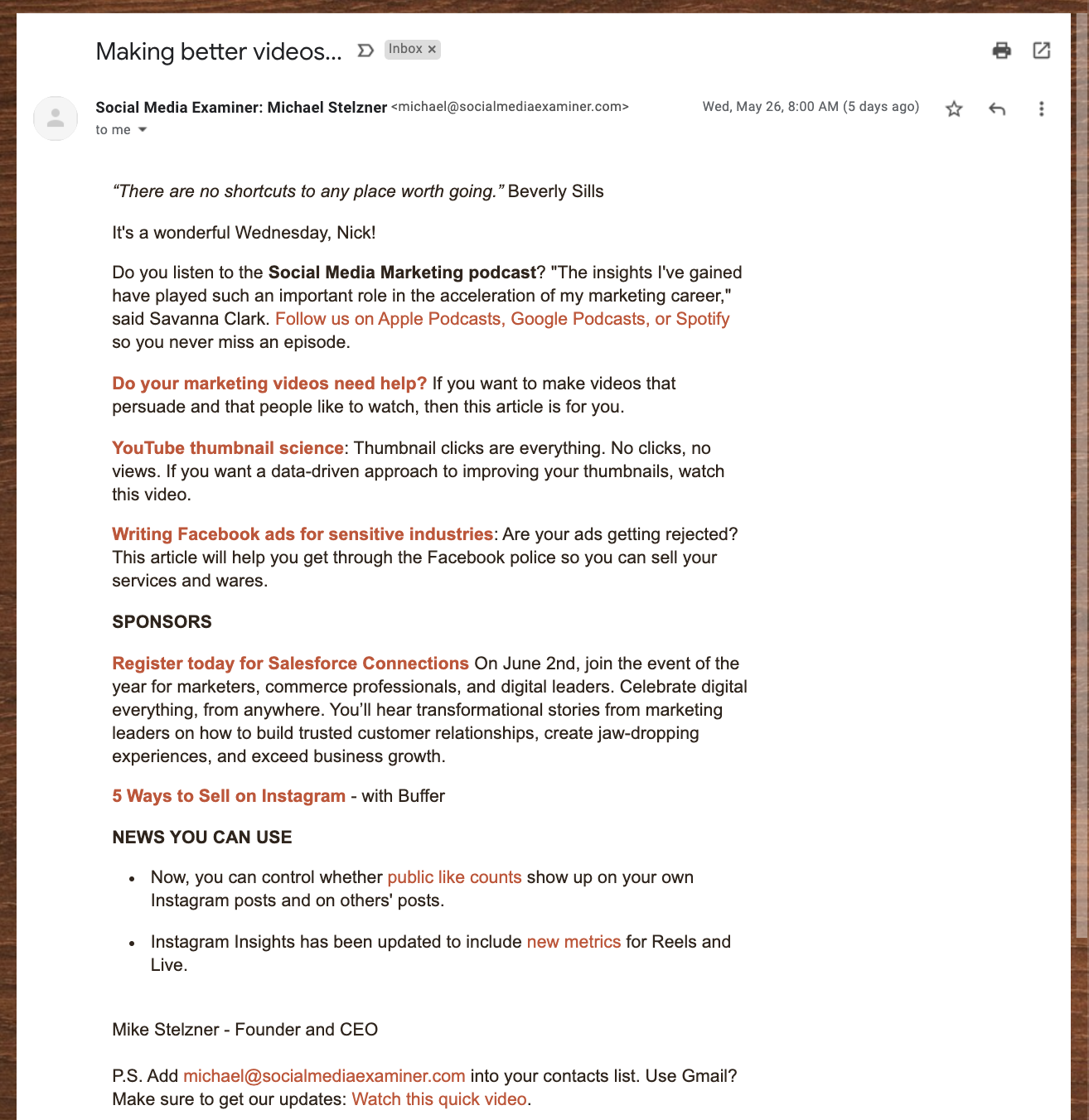
Email requires minimal design skills and directly reaches the people who are interested in hearing from you.
“Nah, I’ve got my followers on (Insert social media platform here), I’ll be fine”
Will you, though?
The last time this platform had an algorithm tweak, people freaked out. For some creators, pay dropped by over 75%. You have incredible writers here, many of whom have rightfully attracted tens of thousands of followers of their work, who increasingly struggle to get in front of their audiences.
That’s because platforms change constantly, and it’s practically guaranteed that how you get in front of people today won’t last forever. Platform-based companies are almost always influenced by P&Ls and investors. It’s a software business; why wouldn’t they follow the numbers? Just look at Facebook. Quick recap for you young whippersnappers:
- In 2010, Facebook Business pages were the hot new online asset. They were fantastic.
- A business could post to their page and reach almost all of their followers.
- Small businesses and corporations alike built pages up to thousands or even tens of thousands of followers.
But year after year, post reach declined. Some of this was from the inherent crowdedness of feeds: The more accounts you follow, the more updates you get, and your feed’s assembly line can only hold so much.
Facebook knows you want this distribution back, so it invites you to buy distribution in the form of ads. 97.9% of Facebook’s revenue comes from ads… so why wouldn’t they do that? Nowadays a Facebook Business page post usually reaches fewer than 5% of followers.
If your audience was only built on your Facebook page, and you didn’t bring this audience over to a platform you can control, there’s not much you can do about it.
Follower count does jack shit
Last July, I had 750 followers on this platform. I now have close to 8,500 as of this writing, and guess what? My traffic for both months was almost exactly the same. Traffic is all over the place for me and is driven by per-article performance, not followership.
Here are my first four months of this year:
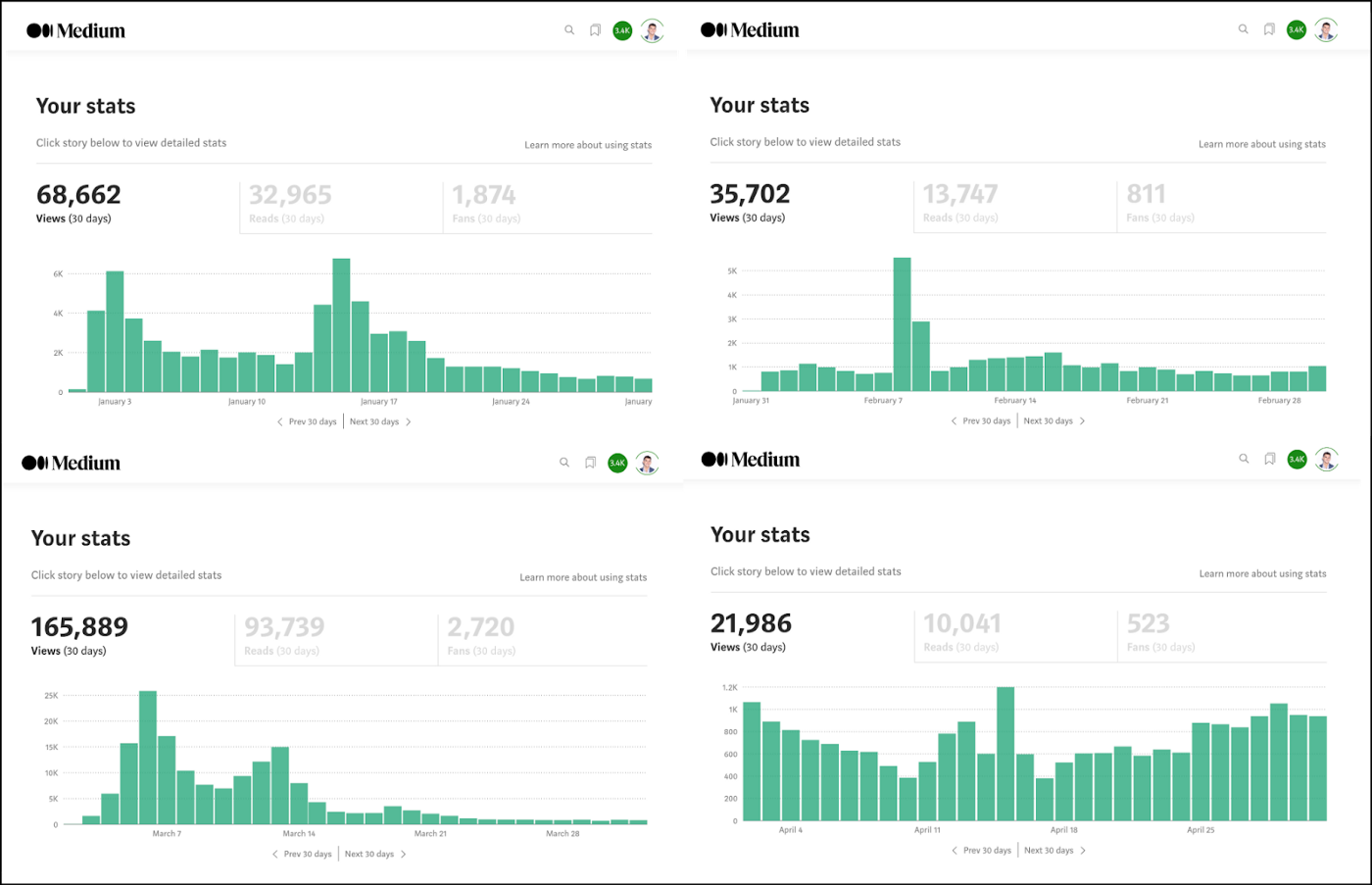
Traffic is hard to predict, and I wouldn’t want to build my livelihood on something that swings this widely.
Meanwhile, my email list has also grown — but since my open rate has stayed within the same range (22%-35% in most weeks), a bigger list means I’m reaching more people and reaching them more frequently.
The only time follower count matters is when you’re trying to position yourself as an influencer in order to land cambassadorships, a book deal, or a TV show. Those are certainly valid approaches: Networks and companies now look to social media to see which personalities have built followings for themselves, then go in for the kill, because these people have proven their show concept can attract an audience. (Examples: Dr. Pimple Popper, Girl Meets Farm). It’s definitely more of an entertainment industry angle, but it can definitely work.
You don’t have to have a ton of followers, though. Followers do wonders for your ego, but they don’t always correlate to important business metrics.
You don’t need a huge audience to have an online business; you just need to have the right audience.
Related: The freebie I use to grow my email list is here for reference.
“I don’t want to have to do a newsletter every week”
So, some bad news: If writing one piece of content a week sounds like too much… you’re probably going to have an uphill battle as a creator.
This is why I push so much on things like writing faster. It’s not to set speed records for publishing; it’s to disarm the perception that writing is a chore. You have to write to have an online business. Put yourself on the hook to write every week and it’ll get easier with time.
“Email is too complicated”
It’s not — and I’m kind of a short fuse on this one. These days, every single email software provider has tutorials and support to give you what you need to get started.
Learning the ins and outs of email is not hard, but we tell ourselves it is because (1) learning a new skill takes time and attention, and (2) most people are intimidated by a newsletter because it requires coming up with new content each week.
Yes, email marketing can hit you with a lot of data. But don’t you want that? You’re exploring the idea of this stuff being your future livelihood. Mitigate the risks. Once you learn how to read the data — and more importantly, what decisions to make based on what the data is telling you — you’ll become increasingly comfortable with the numbers and be more inspired to try new things.

“An email list is too hard to build”
This one is actually valid. It’s harder to persuade someone to give you their email address than it is to invite them to follow you on a social media platform.
When people join your email list, they want to hear from you. Signing up for a list takes more gumption than just following a social media profile. That’s why you should build one. Luckily, there are a few things you can do to more effectively grow your email list.
If you’ve made it this far, you’re at least a little curious about using email to grow your business. So let’s outline a three-step roadmap for growing one specifically as it relates to an online business or side hustle.
Step 1: Brainstorm A Compelling “Lead Magnet”
“Join my newsletter” is a hard sell. Even if your newsletter is hot shit, this call to action has lost its luster over the years because we’ve heard it a million times.
Instead, offer a freebie or free gift to readers who decide to sign up for your list. In online marketing, this is known as a lead magnet. A lead magnet uses neuroscience to redirect readers’ attention toward the problems they have and how your free resource can help solve those problems. Translation: People love free shit. Here are some of the qualities of a good lead magnet:
- It’s quick.We all want instant gratification, so give me a freebie I can reap the benefits of in 15 minutes or less. (It’s for this reason that I don’t love giving people a free PDF copy of a book as a lead magnet. Asking someone to read a whole book in order to understand you is a lot.)
- It creates clarity and solves problems. We all have problems we’d like to solve and shortcuts we’d like to take. Organize information so I don’t have to and you’re my new best friend.
- It’s inspiring. What will downloading this lead magnet give me? Remind me of my hopes and dreams and you’ll have my attention.
What should your lead magnet be? A PDF? A video? A fill-in-the-blank spreadsheet? It depends. I like to think of lead magnet content as falling into one of four buckets:
- Written content — This is my personal go-to, and you’ve seen stuff like this for years. Whitepapers, e-books, checklists, cheat sheets, and so on. Remember: You want a lead magnet to be something that can be consumed in under 15 minutes so that your new subscribers both feel successful and are left wanting more.
- Audio content — This is fairly new territory, but rapidly trending! Perhaps your expertise is best served in audio format; this could be a great option. A new service called Hello Audio lets you package audio content into mini-podcasts and other audio assets without fear of theft. You could also throw audio files into Google Drive and deliver the links to your new subscribers.
- Video content — A video walkthrough can be compelling and engaging. Video lessons, a video series, or a how-to or behind-the-scenes video can all be great lead magnets. Video also feels more premium than other content formats.
- Visual content — Not my territory, but if you’re incredible at infographics, charts, or other visuals, this could be a great option for you.
There are other lead magnet strategies, too: Mini-courses, challenges, quizzes, you name it. Some creators even just offer their past best articles, curated and delivered directly to your inbox.
Focus on what valuable information you want to give your readers first, then decide what format makes the most sense for delivering this info (As well as what modality you might prefer to use). Get creative!
Step 2: Select And Set Up An Email CRM
Email software allows you to send newsletters and other email correspondence to your readers. Most email software also doubles as CRM (Customer Resource Management) software, so if some of your readers become customers or clients, you can mark that accordingly within your database.
Email marketing software is obviously a huge business, and there are dozens of different platform providers to choose from. Here are the four that I most frequently recommend:
- Mailchimp is the big boy in the room; if you have 11 million users, you’re doing something right. Mailchimp is massively popular and is used by newbies and established businesses alike. It’s free to start using.
- ActiveCampaign is my personal battle axe of choice and has been for years. I like how ActiveCampaign was really low cost to start, and I also like that the automations section is visual.
- ConvertKit is also wildly popular with creators. It’s an appropriate pick for creators who are just getting started, but is also used by online business powerhouses like Pat Flynn.
- Flodesk is a newer, woman-owned platform I learned about recently. One of its biggest value propositions is that it offers a flat rate no matter how big your list gets. Considering that many providers tier their pricing based on the size of your list, this is a super attractive option.
There’s also Substack, but I’m not a fan of it for reasons explained here. If you want to launch something like a media publication or want to be a thought leader, Substack could be a solution. But if you want an actual side hustle or business that grows over time, you need ways to send old content to new eyeballs and build out automations. At the time of this writing, Substack doesn’t offer that.
Once you have your lead magnet done and your email list set up, you can invite readers to download it and join your list by creating a web page or landing page. I won’t go into landing pages in this article, but you can read about that strategy here if you like.
Step 3: Promote Your Lead Magnet Often
Former internet marketer Derek Halpern has a formula I like to keep in mind: 20% content creation, 80% content promotion.
Once you have everything set up, be prepared to talk about your free resource… a lot. Technically, you’ll be doing it until you (1) change your lead magnet, or (2) give up on your business.
You’ll probably feel like a broken record. Here’s a quote to keep in mind from Derek Sivers: “What’s obvious to you is amazing to others.”
When you’re actively promoting, your old content is helping new people each and every month! I’ve done one revision on my main lead magnet in the last year; otherwise, it’s been exactly the same.
“What’s obvious to you is amazing to others.” — Derek Sivers
I couldn’t possibly list all of the different strategies there are for promoting your free resources, but here are the ones that work best for me.
Articles
Articles are my preferred way of growing my list, and the same may be true for you as well. I’ve always liked how articles are an easy way to give people a sneak peek of your style and voice. Help someone gain clarity or feel inspired, then invite them to go deeper on the topic by signing up for your list and downloading your lead magnet. Example: One of my absolute highest-performing articles on this platform is this one. There’s loads of information, and then at the end I promote a way for readers to go deeper and take action on the material they’ve just read. It’s not a viral article, but it’s a relevant article to the person I’m trying to attract to my list.
Guest posts or partnerships
This is similar to articles, but with a slightly different focus. Is there a business or person with an audience that you can add value to? Doing a free workshop or Q&A for someone’s community is a win/win because you’re creating content for that brand while also making a new group of people aware of who you are.
Podcast interviews
Podcasts are like tiny niche media outlets. Offer value to someone else’s audience in an interview setting to show off your smarts and your personality. At the end of the interview, promote your lead magnet and tell listeners what they can do if they want to download it. (Ask for permission beforehand to do this.)
A note about using ads to grow your audience
Using Facebook ads, Instagram ads, or YouTube ads to promote your lead magnet can also be an option, but I don’t recommend it to start unless you have a clear and proven system from which you can make back your investment on the ads.
Sure, you’ll probably get subscribers from your ads… but who are those people? Will they buy stuff? Do you even sell anything yet? Using ads from the start can sometimes be a crutch that prevents you from doing the real work of creating helpful content and earning your audience.
If you have the money for ads, that money would be better spent on a coach or some courses to help you advance your online business efforts. Media buying is its own art form and takes months of trial and error; don’t go after it until you already have a proven track record of making sales.
Now Do This
There’s a saying in internet marketing: “The best time to start an email list was two years ago. The next best time to start is today.”
Hopefully some of the information shared above is helpful. But none of it matters unless you start taking action on it.
- Create a lead magnet that adds value for your readers.
- Choose and set up an email CRM, then stick with it.
- Promote your lead magnet and start growing your list today.
Over time, you’ll learn more about what works and what doesn’t. You might even burn through a few niches and pivot until you find your sweet spot.
Stay in action, get messy along the way, and eventually you’ll find the right combination that begins building your email list up to 1,000 subscribers and beyond.
Thanks For Reading 🙏🏼
Keep up the momentum with one or more of these next steps:
📣 Share this post with your network or a friend. Sharing helps spread the word, and posts are formatted to be both easy to read and easy to curate – you'll look savvy and informed.
📲 Hang out with me on another platform. I'm active on Medium, Instagram, and LinkedIn – if you're on any of those, say hello.
📬 Sign up for my free email list. This is where my best, most exclusive and most valuable content gets published. Use any of the signup boxes on the site.
🏕 Up your writing game: Camp Wordsmith® is a content marketing strategy program for small business owners, service providers, and online professionals. Learn more here.
📊 Hire me for consulting. I provide 1-on-1 consultations through my company, Hefty Media Group. We're a certified diversity supplier with the National Gay & Lesbian Chamber of Commerce. Learn more here.


